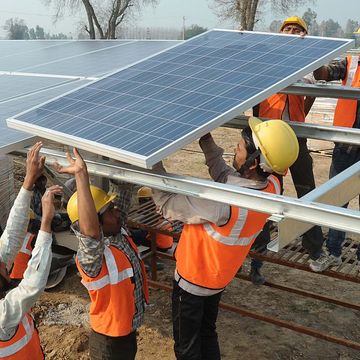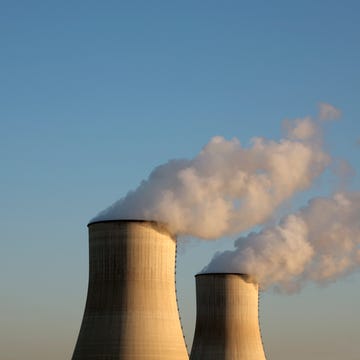In an election year when access to domestic oil supplies will figure prominently in the presidential campaign, uncertainty is growing over how much life the critical Trans-Alaska Pipeline has left in it. The pipeline transports roughly 14 percent of U.S. crude oil supplies, yet energy companies are starting to suggest that the lifeline to some of the richest oil fields in the country may not be worth the expense of upkeep. Oil production in Alaska's North Slope oil fields has declined every year since production peaked in 1988, and the consortium of energy companies that own the line say they are worried: If production slows down too much, the pipeline can become unsafe—or at least uneconomical—to run. But some watchdogs say the industry may be fudging its numbers as part of a ploy to get access to new, potentially rich oil fields.
All the oil produced in the fields near Prudhoe Bay depends on the Trans-Alaska Pipeline System. Hailed as a marvel of engineering when it opened in 1977, the pipeline is a complex system of pipes and pump stations that last year sent 212 million barrels of crude 800 miles from the North Slope oil fields south across three mountain ranges to Valdez on Prince William Sound, 120 miles east of Anchorage. The line was a major engineering feat 35 years ago, and keeping it running is becoming an engineering challenge almost as daunting, especially in winter when Alaska's bitter temperatures leave the pipeline and its pump stations vulnerable to ice, wax buildup, and other operational problems.
Although there are still substantial oil reserves left in Prudhoe Bay, which has been drilled for decades, the oil companies say the end is in sight. John Felmy, chief economist for the American Petroleum Institute, says that now those companies believe the most profitable resources to tap will be the easy-to-reach oil in places they're not yet allowed to drill: parts of the National Petroleum Reserve, the Arctic National Wildlife Refuge, and the Chukchi and Beaufort seas just offshore of the North Slope. ANWR alone holds 10 billion barrels of untapped oil, Felmy says, but drilling there is a huge environmental issue, and so far the U.S. government has not let oil companies in.
While the companies lobby, the amount of oil moving through the pipeline continues to dwindle. Flows peaked at 2.1 million barrels per day 24 years ago. By last year they dropped to about 579,000 barrels per day. That decline is creating a very expensive engineering problem, says the pipeline's operator, Alyeska Pipeline Services—a company owned by the North Slope's major oil industry players including BP, ExxonMobil, Chevron, ConocoPhillips, and Koch Industries.
To put the problem simply: The lower the average flow of oil through the pipeline, the harder it is to keep that oil moving. As the flows of oil in the line drop, the velocity of the oil flow decreases, too, increasing the time it takes for the oil to reach Valdez. The longer the oil is in the pipeline, the cooler the oil gets. That decreases the turbulence in the oil, which slows the flow even more. Alyeska's own study, done last June, suggested that if flows in the pipeline were to drop to 400,000 barrels per day in January, the oil, which enters the line at around 110 degrees Fahrenheit, would dip to temperatures below 32 degrees by the time it reached the midpoint of the pipeline. The study concluded that the pipeline could carry no less than 300,000 to 350,000 barrels of crude per day during the winter before major flow problems prevent the pipeline from operating safely.
"As the crude cools, the concern is that water dropout can pool in low areas. These areas become more prone to bacteria growth which can lead to corrosion of the pipe," Alyeska spokeswoman Michelle Egan says. Wax builds up in the line at cool temperatures, too, constricting the flow of oil in the line and requiring regular maintenance to scrape away the wax. "The other issue they're facing is the possibility of an unsuccessful cold restart," says Louis Kozisek, chief engineer for the Alaska State Pipeline Coordinator's Office. "The pipeline could go down in arctic temperatures and cool off quickly to the point where ice could form on the inside."
Still, Kozisek says, all the engineering problems facing the pipeline are solvable with upgrades and modifications, such as the heaters that Alyeska has proposed to install along the pipeline, and that the pipeline could be maintained indefinitely. The harder—and more controversial—question is whether it's worth the money, especially if ANWR and other areas remain off-limits. "It's hard to separate engineering and economic issues sometimes, and this is one of those instances," he says. "When does it become uneconomical to do so with oil revenues dropping and maintenance costs increasing as systems age?"
This question is now the subject of a political fight in Alaska. The owners say they're reluctant to invest in pipeline upgrades or any North Slope operations unless Alaska lawmakers reduce the state's oil production tax, which is 5 percent of the gross value of the oil at the point of production. "The tax rate increases as [oil] price increases," BP spokesman Steve Rinehart says, "and the effect of that is when oil starts climbing up in the $80s and $90s—where you might make at least a promise of a return on investment—the state's share increases."
But a December 2011 ruling by Alaska Superior Court Judge Sharon Gleason threw a wrench into this fight. While assessing the taxable value of the Trans-Alaska Pipeline, Gleason ruled that Alyeska's low-flow study was disproved by court testimony from former Alyeska COO Dan Hisey and Jerry Modisette, a consultant and board member of the Pipeline Simulation Interest Group, as well as by an internal BP study that was released in court documents. The BP study, conducted without the knowledge of Alyeska, suggested that if the oil in the pipeline were heated along its route, TAPS could operate with a throughput down to 70,000 barrels per day—much lower than the 300,000 barrel minimum Alyeska's study suggested.
Alyeska spokeswoman Katie Pesznecker defends the organization's study, saying it was intended to look at the challenges of moving between 300,000 and 600,000 barrels per day through the pipeline—not to give a concrete technical or economic lower limit. While claiming the Alyeska study has little credibility, Gleason concluded that the most viable estimate for the lowest flow the pipeline could handle is 100,000 barrels per day.
To Kozisek, these numbers aren't mutually exclusive: Alyseka's study asked what would need to happen for the pipeline to keep working down to 300,000, while the BP study Judge Gleason cited asked how low the flow could possibly go with radical modifications. Nevertheless, the ramifications of the two studies are a world apart. BP and the other pipeline-owning companies claimed in court that about 3 billion barrels of recoverable oil remain on the North Slope, estimating that the pipeline's life would end around 2032. Gleason, relying on testimony from a former state oil-production forecaster whom she found more credible, ruled that the pipeline could access more than 7 billion barrels there, extending the pipeline's life to 2065.
Charles Clusen is the Alaska director for the Natural Resources Defense Council, one of the environmental groups accusing the oil companies of manufacturing an argument—we need more oil or the pipeline can't keep running—as a reason to open the ANWR and the Chukchi and Beaufort seas to drilling. Instead, NRDC is encouraging the industry to invest in the Trans-Alaska Pipeline to get more out of Prudhoe Bay. An NRDC study, released in September, conducted by an independent consulting firm recommends that the industry spend up to $721 million in shoring up the pipeline to withstand flows down to 150,000 barrels per day, possibly generating up to $28 billion by tapping oil in the Prudhoe Bay area that would be left untouched if the pipeline is shut down. "Making a modest investment with an extremely high payout will mean that TAPS can continue to operate and is not in danger of being shut down in the near future," the study concludes.
Clusen says that Gleason's decision shows there are many other oil reserves available to the oil industry that the companies are leaving out when they say they're running out of oil and have to tap ANWR to get more. "There is no crisis here, and the pipeline is not shutting down anytime soon, at least not for 50 years," he says. "Even if there's no new oil whatsoever, with some modest investments in heaters, this pipeline can go on for a long time."
But the best way to ensure the pipeline will remain running and in good physical condition for a long time is to make sure there is plenty of oil to produce on the North Slope, says Graham Smith, public information officer for the State Pipeline Coordinator's Office. "The integrity is fine; the steel is in good condition," he says. "The magic formula for getting rid of all these operational challenges is just to increase throughput. More oil, more heat, and less challenges with icing and gelling. If they found another source of oil, they'd just continue to use TAPS. They might not have to make modifications if they had another source of oil."
Whether they'd be willing to pay for those modifications is a separate question.













